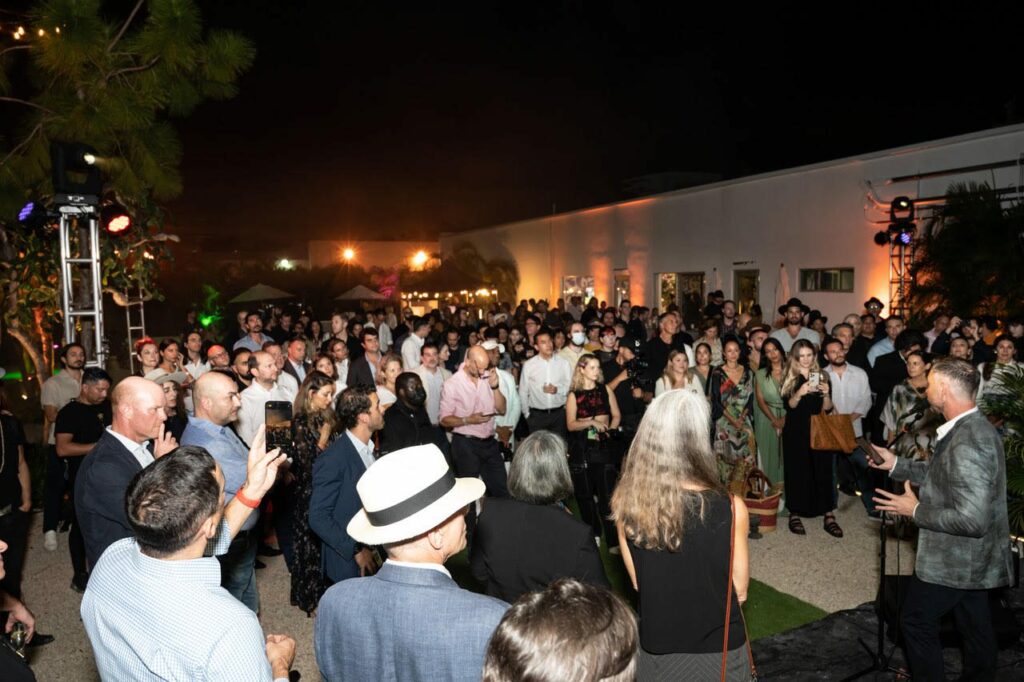By Riley Kaminer
Amid a competitive landscape of Art Basel events, 600 people made it out to Little Haiti to catch a glimpse of what our urban future might – or perhaps should – look like.
The Future of Cities, a Miami-based platform rethinking how we develop our communities, hosted these forward-thinking attendees for the pre-opening of their Climate and Innovation Hub. Located in Little Haiti, the Hub is designed to be Miami’s first net-zero office building thanks to a mixture of technologies such as solar panels and rainwater catchment systems.

“I don’t think there could be a more important thing to do than to focus on climate change and sea level rise – and adaptation and mitigation within the city that will be most affected by it,” Tony Cho, CEO and founder of Future of Cities, told Refresh Miami.
“Also to demonstrate to people how to have an energy efficient building, how to repurpose an old building, and how to have the community participate in the conversation.” While the goal is for the building to be net-zero, Cho said that the building in its current form will be approximately 80-85% of the way there.

Cho, a real estate developer who was an early pioneer in Wynwood, underscored the protagonistic role technology will play in building a more sustainable climate future. “A lot of these innovations within climate tech and blue tech are going to help transform the world,” he said. Cho signaled particular excitement around carbon capture tech, the concrete 3D printing of homes, and energy innovations leveraging geothermal and wind power.
To this end, the Future of Cities will be working with Miami-Dade County to attract climate tech companies to our county. “Instead of being the victim of climate change, I think that we should be the poster child of climate solutions,” said Cho.
“We’re focused on leveraging web three and blockchain to create equity within underserved communities,” Cho explained, taking us on a virtual tour of some of the art exhibitions located in the Hub, including a carbon capture sculpture created in partnership with Climatecoin and Miami-based ClimateTrade.
For Cho, social justice and climate justice go hand in hand. “Climate impacts the most vulnerable communities more than well-to-do communities because they are the ones that have less mobility, less ability to adapt to what’s going on.”
“I think that social justice and environmental justice are one in the same,” he said, notinconcerns about climate gentrification in places as close to home as Little Haiti and as far-reaching as African and Southeast Asia.
Beyond climate gentrification, another major point of friction preventing Miami from becoming a global climate innovator are climate change deniers, who Cho said “just need to wake up, get their head out of the sand, and see what’s happening before it’s too late.”
For now though, Cho expressed a hope for this Hub to paint an inspirational picture for Mother Earth’s climate future. “There are an endless amount of possibilities,” he said. From Little Haiti to the world.

READ MORE IN REFRESH MIAMI:
- ClimateTrade establishes Miami HQ to expand decarbonization platform stateside
- NFTs take flight with Miami-based TravelX
- Meet the entrepreneurs developing Living Seawalls to help combat rising sea levels, shaping the climate-tech space
- Chilean anti-corruption startup lands in Miami to bring compliance to the blockchain
MORE TECHBASEL COVERAGE:
- La Casa serves up heaping helping of #MiamiTech’s best
- With $1.25M Knight Foundation grant, Oolite Arts will enable Miami’s creative community with new technology
- Step into the future of web3, from Flagler Street to the metaverse
- At Art Basel web3 events, experts make the case for crypto amid background of uncertainty
- In a show of energy, optimism and talent, 1,000 turn out for Venture Miami Tech Hiring Fair at Miami Dade College
- Miami’s Blackdove debuts digital-art gallery in Wynwood, kicking off a global network
- What might life and work be like in 2030 and beyond? Find out at FilmGate’s XR festival
- 5+ things to know in #MiamiTech: Get ready to clone yourself for TechBasel/Art Week & more
- Superlogic lands $7.6M strategic round to pioneer the future of loyalty points - April 19, 2024
- AI, climatetech and healthtech reign supreme on Day 1 of eMerge Americas’ 10th anniversary - April 18, 2024
- Brought together by tech, kept together by culture: Miami’s protagonistic role in LatAm’s startup story - April 15, 2024





